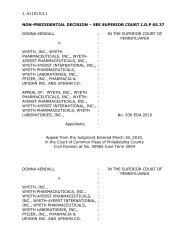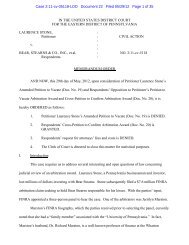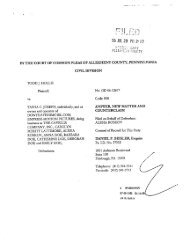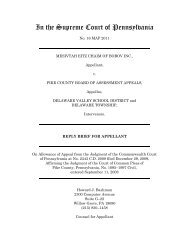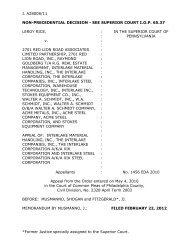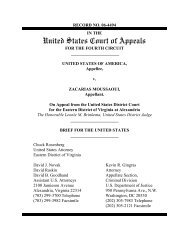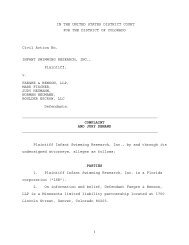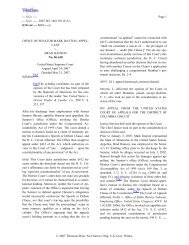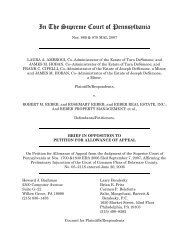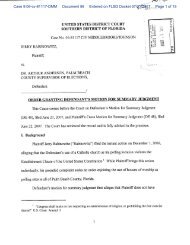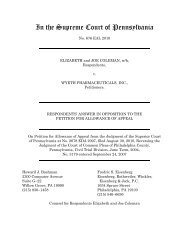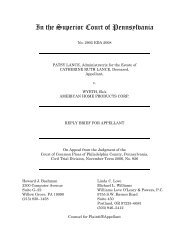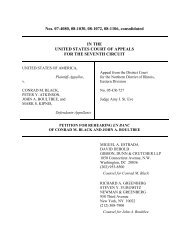DePinto v. Bayonne Board of Education
DePinto v. Bayonne Board of Education
DePinto v. Bayonne Board of Education
You also want an ePaper? Increase the reach of your titles
YUMPU automatically turns print PDFs into web optimized ePapers that Google loves.
Case 2:06-cv-05765-JAG-MCA Document 18 Filed 09/19/2007 Page 18 <strong>of</strong> 28<br />
On the other hand, the image here is not pr<strong>of</strong>ane, nor does it contain sexual innuendo. It<br />
is, in fact, a rather innocuous photograph – rows and rows <strong>of</strong> young men, all facing the same<br />
direction and wearing the same outfit (with no identifying marks or patches). The photograph<br />
contains no visible swastikas, and the young men are not giving the infamous “sieg heil” salute.<br />
As noted by Plaintiffs’ counsel at oral argument, the young men might easily be mistaken for a<br />
historical photograph <strong>of</strong> the Boy Scouts. The image may be interpreted as insulting or thought to<br />
be in poor taste, but it is not “lewd,” “vulgar,” “indecent,” or “plainly <strong>of</strong>fensive” as set forth in<br />
8 Fraser. Fraser and Kuhlmeier do not apply. Thus, this Court analyzes the speech here under the<br />
general rule <strong>of</strong> Tinker. See Saxe, 240 F.3d at 214.<br />
c. Tinker Analysis<br />
As stated above, Tinker requires a school district to demonstrate, before prohibiting a<br />
student’s speech, that the speech will “substantially interfere with the work <strong>of</strong> the school or<br />
impinge upon the rights <strong>of</strong> other students.” Tinker, 393 U.S. at 509. Defendants make no such<br />
showing. The certifications <strong>of</strong> Defendants McGeehan, Quinn, and LoRe only assert that<br />
differ greatly. While it is unclear whether this Court would so find under Tinker or Fraser (it is<br />
eminently more likely that such a symbol would create a disturbance under Tinker), this Court<br />
believes that such a display would likely be “plainly <strong>of</strong>fensive” under Fraser; however, the<br />
resolution <strong>of</strong> that dispute is not before this Court.<br />
8<br />
It should be noted that this Court posed a hypothetical during oral argument that the<br />
“message” <strong>of</strong> the Button is that school administrators and supporters <strong>of</strong> the uniforms were akin to<br />
Nazis. (T49:20 to T50:3 (this abbreviation refers to the page and line <strong>of</strong> the Transcript <strong>of</strong> the<br />
motion hearing held in this case on December 15, 2006).) Such an argument, in this Court’s<br />
view, might dictate a different analysis. This message might cross the line drawn in Tinker,<br />
forbidding speech which “intrudes upon . . . the rights <strong>of</strong> other students” or “colli[des] with the<br />
rights <strong>of</strong> other students to be secure and to be let alone.” Tinker, 393 U.S. at 508. Defendants,<br />
however, did not avail themselves <strong>of</strong> this argument and it is not this Court’s business to make<br />
those arguments in Defendants’ stead.<br />
18



